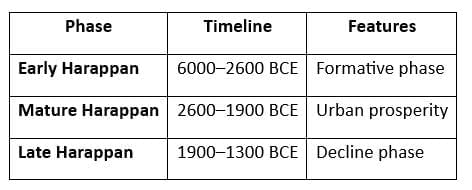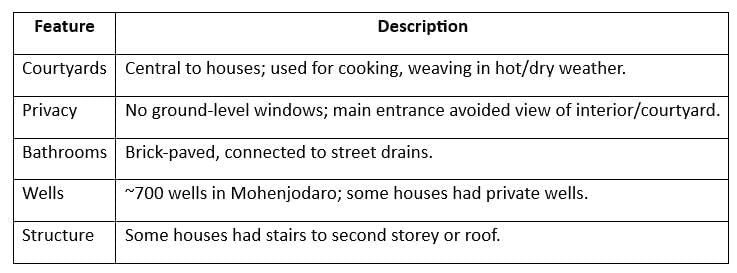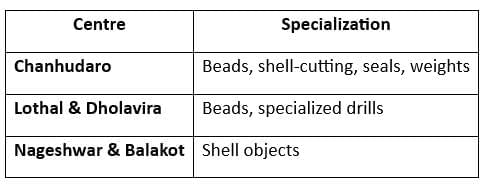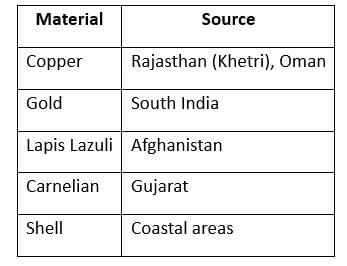Humanities/Arts Exam > Humanities/Arts Notes > History Class 12 > Cheat Sheet: Bricks, Beads and Bones
Cheat Sheet: Bricks, Beads and Bones | History Class 12 - Humanities/Arts PDF Download
The Harappan or Indus Valley Civilisation (6000 BCE–1300 BCE) is known through archaeological evidence like houses, pots, ornaments, tools, and seals. The Harappan seal, made of steatite with animal motifs and undeciphered script, is a key artefact. Interpretations evolve, but some aspects remain unknown.
Phases of Indus Valley

Beginnings
- Many small pre-Harappan cultures: pottery, agriculture, herding.
- Few large buildings.
- Break between Early & Mature Harappan: evidence of large-scale burning + abandonment of sites.
Subsistence Strategies

Mohenjodaro: A Planned Urban Centre

- Bricks: Standardized (ratio 1:2:4).
- Drainage: Streets → drains → houses.
- Domestic Architecture: Courtyard houses, privacy walls, brick bathrooms, wells (~700), stairs to second storey.
- Great Bath: Waterproof tank, steps, ritual significance suspected.
Domestic Architecture

Tracking Social Differences
Burials

Luxuries
- Utilitarian vs. Luxuries: Utilitarian (common materials, widespread); luxuries (rare, costly materials, complex technology).
- Examples: Faience pots, gold jewellery (concentrated in Mohenjodaro, Harappa); spindle whorls of faience.
Craft Production

- Beads: faience, stone, terracotta; decorated (incising, painting, etching).
- Red carnelian beads = fired in stages.
- Indicators of craft centers: raw material, unfinished goods, tools, waste.
Procuring Materials

Contact with Distant Lands

- Transport: bullock carts, Indus river routes, sea trade.
- Foreign links:
- Oman (nickel copper, Harappan jars).
- Mesopotamia: Meluhha (Harappan region), Dilmun (Bahrain), Magan (Oman).
- Harappan seals, dice, weights found in Mesopotamia.
Seals, Script, Weights

Ancient Authority

End of the Civilization

Discovering the Harappan Civilization

- Post-Partition: Major sites in Pakistan; Indian archaeologists found new sites in Kutch, Punjab, Haryana.
- Modern Efforts: International interest since 1980s; surface exploration, scientific techniques.
Problems of Piecing Together the Past

Problems of Interpretation

The Harappan Civilization, known for its urban planning, craft production, and trade, left a rich archaeological legacy. Despite undeciphered script and interpretive challenges, artifacts like seals, standardized bricks, and weights reveal a sophisticated society. Its decline by 1300 BCE marked the end of urbanism in the region for over a millennium.
The document Cheat Sheet: Bricks, Beads and Bones | History Class 12 - Humanities/Arts is a part of the Humanities/Arts Course History Class 12.
All you need of Humanities/Arts at this link: Humanities/Arts
|
30 videos|274 docs|25 tests
|
FAQs on Cheat Sheet: Bricks, Beads and Bones - History Class 12 - Humanities/Arts
| 1. What were the main subsistence strategies used by ancient civilizations? |  |
Ans. Ancient civilizations primarily relied on three main subsistence strategies: hunting and gathering, pastoralism, and agriculture. Hunting and gathering involved foraging for wild plants and hunting animals, while pastoralism focused on the herding and breeding of livestock. Agriculture marked a significant shift, as communities began to cultivate crops and domesticate animals, leading to more stable food sources and the development of permanent settlements.
| 2. How did agricultural technologies impact early urban centers like Mohenjodaro? |  |
Ans. Agricultural technologies, such as irrigation systems and crop rotation, significantly contributed to the growth of urban centers like Mohenjodaro. These innovations allowed for increased food production, which supported larger populations. The surplus of food enabled trade and economic specialization, fostering urban development and complex societal structures.
| 3. What characterized the domestic architecture of Mohenjodaro? |  |
Ans. The domestic architecture of Mohenjodaro was marked by well-planned layouts, with houses built from standardized baked bricks. Many homes featured multiple rooms, drainage systems, and access to water, indicating advanced urban planning. The uniformity in construction suggests a centralized authority and a degree of social organization within the community.
| 4. How did social differences manifest in the societies of ancient urban centers? |  |
Ans. Social differences in ancient urban centers often manifested through variations in housing, access to resources, and roles within the community. Wealthier individuals typically lived in larger, more elaborate homes, while lower-status individuals occupied smaller dwellings. Additionally, specialized crafts and trade roles contributed to a stratified society, where some individuals gained higher status based on their skills or wealth.
| 5. What evidence supports the existence of craft production in ancient civilizations? |  |
Ans. Evidence of craft production in ancient civilizations can be found in the discovery of specialized tools, production sites, and artifacts such as pottery, textiles, and metalwork. Archaeological findings often reveal workshops or areas designated for specific crafts, along with remnants of raw materials, indicating a system of production that catered to both local and distant markets.
Related Searches





















